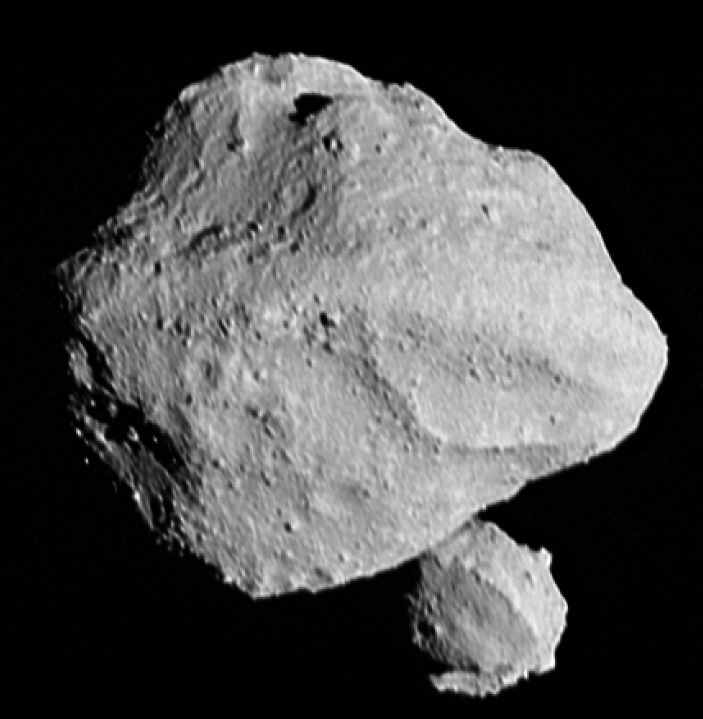NASA’s Lucy mission hits the jackpot on its very first asteroid flyby earlier this week.
Welcome to Dinkinesh. NASA’s Lucy mission flew past its first target of Wednesday, November 1st, and turned up a surprise: 152830 Dinkinesh (meaning ‘marvelous’ in the Amharic language) is not one asteroid, but two (!)
The Dinkinesh Flyby
The the 16,000 kilometers per hour (10,000 mph) flyby occurred at a range of 430 kilometers (270 miles), and served as a test for Lucy’s instruments on its way to the Trojan asteroids. Closest approach was on November 1st and occurred at 16:54 Universal Time (UT)/12:54 PM U.S. Eastern Time (EDT). The image really caught lots of us off guard, revealing a boulder-strewn surface on both small worlds. At most, we were expecting a few small pixels, so the dramatic resolution was a huge bonus.
The L’LORRI Long Range Reconnaissance Imager and T2Cam tracking cameras really demonstrated their resolution and pinpoint tracking capability on this first flyby. If the names sound familiar, its because the instruments are similar to those carried aboard NASA’s New Horizons mission, with completed a flyby past Pluto and Charon in 2015.
The flyby is reminiscent of New Horizons’ dramatic 2019 rendezvous with the Kuiper Belt Object 486958 Arrokoth. That passage also surprised scientists, with the object’s strange twin-lobed structure.
A Tiny Moonlet
The Dinkinesh moonlet is an estimated 220 meters (720 feet) across, about the size of an Iowa-class battleship. Variations in brightness seen in Dinkinesh on approach hinted at the presence of the unseen moon. As of yet, no orbital period for the moon has been published.

Dinkinesh is a small main belt asteroid, discovered in 1999. Up close, 790 meter-wide Dinkinesh actually looks lots like 101955 Bennu, visited by OSIRIS-REx. The next target for Lucy is asteroid 52246 Donaldjohanson in 2025. Lucy will perform another Earth flyby for a gravitational assist later next year in December 2025. Lucy delivered a great portrait of the Earth and Moon pair during the October 2022 flyby:

“Dinkinesh really did live up to its name; this is “marvelous’” says principal investigator Hal Levison (Boulder-SwRI) in a recent press release. “When Lucy was originally selected for flight, we planned to fly by seven asteroids…now with this satellite, we’ve turned it up to 11.”
What’s Next for Lucy
Lucy takes its name from the 3.2-million year old Lucy hominid fossil, which in turn was named from the Beatles song ‘Lucy in the Sky With Diamonds.’ The naming alludes to the fossils of planetary formation sought out by planetary researchers in the Jupiter Trojan asteroids. Not only does the spacecraft’s L’TES instrument carry a disc made of lab-grown diamonds, but it also has a plaque with poems, speeches and quotes from Earth.

Launched in 2021 atop an Atlas V rocket from Cape Canaveral Space Force Station, the main goal of Lucy is the exploration of the Trojan asteroids, located at stable L4 and L5 points ahead and behind massive Jupiter in its orbit. Plans at launch called for Lucy to visit seven Trojans from 2027 through 2033, though the number has now grown to 11. This now includes two main belt asteroids, plus two moonlets discovered since launch.

Asteroid 15094 Polymele targeted for a Lucy flyby in 2027 was found to possess a moonlet in March 2022. This moonlet is informally named ‘Shaun’ and was discovered during a stellar occultation. There’s an intriguing campaign underway worldwide to observe stellar occultations by target asteroids for the mission. This effort will help map asteroid profiles, refine orbits, and tease out undiscovered moonlets. This is a professional and amateur collaboration, with several events coming right up in 2024.
Lucy will be an amazing mission to follow in the coming decade. Now, what will we name Dinkinesh’s new companion moon?

Dr. Thomas Hughes is a UK-based scientist and science communicator who makes complex topics accessible to readers. His articles explore breakthroughs in various scientific disciplines, from space exploration to cutting-edge research.








